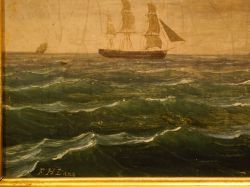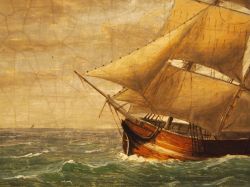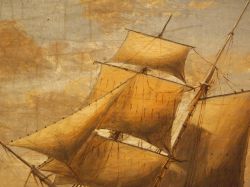loading 
Fitz Henry Lane
HISTORICAL ARCHIVE • CATALOGUE RAISONNÉ • EDUCATIONAL RESOURCE
An online project under the direction of the CAPE ANN MUSEUM
An online project under the direction of the CAPE ANN MUSEUM
Catalog entry
inv. 34
Two Ships in Rough Seas
Ships in Rough Seas; Two Ships
1847 Oil on panel 8 x 12 in. (20.3 x 30.5 cm) Signed and dated lower left: F H Lane 1847
|
Supplementary Images
Provenance (Information known to date; research ongoing.)
Alphonso Mason
Helen B. Mason Rutherfoord, by descent through the Mason family
Mr. and Mrs. John N. Estabrook, Chicago, 1946
Cape Ann Museum, Gloucester, Mass., October 1981
Exhibition History
No known exhibitions.Published References
Hoffman, Katherine. "The Art of Fitz Hugh Lane." Essex Institute Historical Collections 119 (1983)., p. 30, Ships in Rough Seas.
Wilmerding, John. "Fitz Henry Lane & Mary Blood Mellen." American Art Review 19, no. 4 (2007)., p. 175, Two Ships.



.jpg)
Commentary
Relatively few of Lane's small paintings could be characterized as fully developed sketches for larger works. Two Ships in Rough Seas might qualify, though we have no direct record of a larger work that was derived from it. There are a number of similar compositions, such as Brig Off the Maine Coast, 1851 (inv. 241), and particularly a painting, Ships Leaving Boston Harbor, 1847 (inv. 265), done the same year as this one. This painting is on a wooden panel, only 8 x 12 inches. It is signed and dated 1847 (quite early in Lane’s painting career), so it evidently left the studio as a finished work.
The water is convincing and energetic; the sky is full of light and the soft clouds that Lane became so adept at. The paint application is quite thin, allowing the ground to show through, particularly in the waves, which gives them a translucence and light that is difficult to achieve in such a small work. This thinness of paint is intentional here, not the result of overcleaning as with so many Lanes. Painting on panel requires a thinner paint application as there is no absorbtion by the canvas. The perspective in the rendition of the near vessel is a bit awkward, and the hull of the far ship a bit perfunctory—unusual for Lane even at that early date. The hull of the near vessel is not sitting in the water with quite its proper weight and mass, and the shading of the hull is not fully integrated with the water. These flaws may be due to the small size of the work or the difficulty of blending paint on panel. Or they may simply show the painting to be an early learning experience on the road to the full mastery of these elements that Lane would exhibit in the next few years.
The vessel in the foreground is a half brig (more formally hermaphrodite brig) having a hull form best described as “burdensome.” Full ends and high bulwarks have contributed to this awkward appearance. Designed for large carrying capacity, this vessel type was used in the coastal packet trade, transporting cargoes and passengers over longer distances between specific scheduled ports. (Shorter packet routes were covered by sloops and schooners.)
Despite the small, quickly rendered image, Lane has given the brig a surprising amount of detail. All of the major parts of standing and running rigging are present, ratlines on the main shrouds being the most notable omission. Selvedge and tabling seams are absent on the sails, but reef points and cringles are in their proper places. Planking seams are hinted at with brush strokes, but wales and thick plank are where they should be. The wonder is that Lane was able to depict this detail so clearly and accurately with such economy of paint and brushwork.
This image may have served as a visual aid, if not a color sketch, for his painting Ships Leaving Boston Harbor, 1847 (inv. 265), which was made the same year. The vessel in the latter was a brig (square-rigged on both masts), but the hull form and pose are the same, as are the conditions of wind, sea, and light. Only colors have changed to give a more dramatic effect. Possibly Two Ships in Rough Seas was an exercise: a painted sketch focusing on the angle of the vessels and the direction of the waves in a convincing atmosphere, which was repeated in a number of works in the next few years. In any case, because it is signed and dated Lane must have felt that it was suitable for sale, even without his usual exacting finish.
– Sam Holdsworth and Erik Ronnberg
Ships Leaving Boston Harbor, 1847 (inv. 265)
Brig Off the Maine Coast, 1851 (inv. 241)